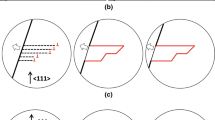Abstract
This paper reports an experimental investigation on the effect of multiple twinning on the interface population in two low stacking-fault alloys. This is an important topic for grain boundary engineering because annealing twinning is the indirect cause of improved intergranular corrosion resistance in this class of materials. Proportions of Σ 3n (n = 1–5) boundaries were analysed in both a brass specimen and a superalloy specimen where the boundaries had been processed so as to be very mobile and less mobile respectively. When Σ 3 twin boundaries (as distinct from Σ 3 grain boundaries) are discounted, the Σ 3n distribution for both specimens had a peak at Σ 9, because Σ 3 + Σ 9 → Σ 3 occurs more frequently than Σ 3+Σ 9 → Σ 27. The distributions and reactions between various Σ 3n values are described and discussed in detail. A novel trace analysis procedure is used to extract information from Σ 3 boundaries to decide whether or not they are annealing twins, and so provide a convenient means to assess proportions of twin and non-twin Σ 3s. The data show unambiguously that a significant proportion of Σ 3s are not on 111, and these boundaries have on average higher angular deviations from the exact Σ 3 reference misorientation than do other Σ 3s. A population of Σ 3s which were vicinal to annealing twins were also recorded. These data support the contention that profuse annealing twinning produces concurrently many not-twin Σ 3s, which are pivotal in grain boundary engineering.
Similar content being viewed by others
References
T. Watanabe, Res. Mech. 11 (1984) 47.
M. Shimada, H. Kokawa, Z. J. Wang, Y. S. Sato and I. Karibe, Acta Mat. 50 (2002) 2331.
V. Randle, Acta Mat. 47 (1999) 4187.
D. C. Crawford and G. S. Was, Met. Trans. 23A (1992) 1195.
G. Gottstein, Acta Met. 32 (1984) 1117.
P. J. Wilbrandt and P. Haasen, Z. Metallk. 71 (1980) 273.
V. Randle, Inter. Sci. 10 (2002) 271.
D. G. Brandon, Acta Met. 14 (1966) 1479.
G. Palumbo and K. T. Aust, Acta Met. Mat. 38 (1990) 2343.
V. Randle, Acta Mat. 46 (1997) 1459.
V. Randle, P. Davies, H.Davies, in “Proc. ICOTOM12,” edited by J. A. Szpunar (NRC Research Press, Canada, 1999) p. 1196.
V. Randle and H. Davies, Ultramicroscopy 90 (2002) 153.
V. Randle, Scripta Mat. 44 (2001) 2681.
S. I. Wright and R. J. Larsen, J. Microsc. 205 (2002) 245.
I. Maclaren and M. Aindow, Philos. Mag. 76A (1997) 871.
V. Randle and B. Ralph, Acta Met. 34 (1986) 891.
Author information
Authors and Affiliations
Corresponding author
Rights and permissions
About this article
Cite this article
Randle, V. The influence of annealing twinning on microstructure evolution. J Mater Sci 40, 853–859 (2005). https://doi.org/10.1007/s10853-005-6501-8
Issue Date:
DOI: https://doi.org/10.1007/s10853-005-6501-8




